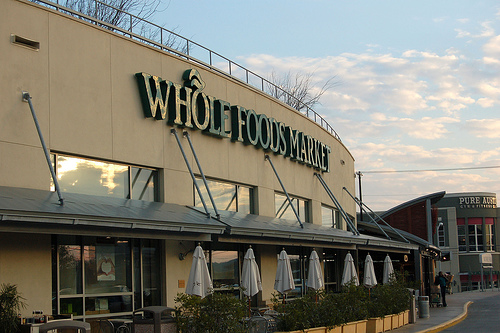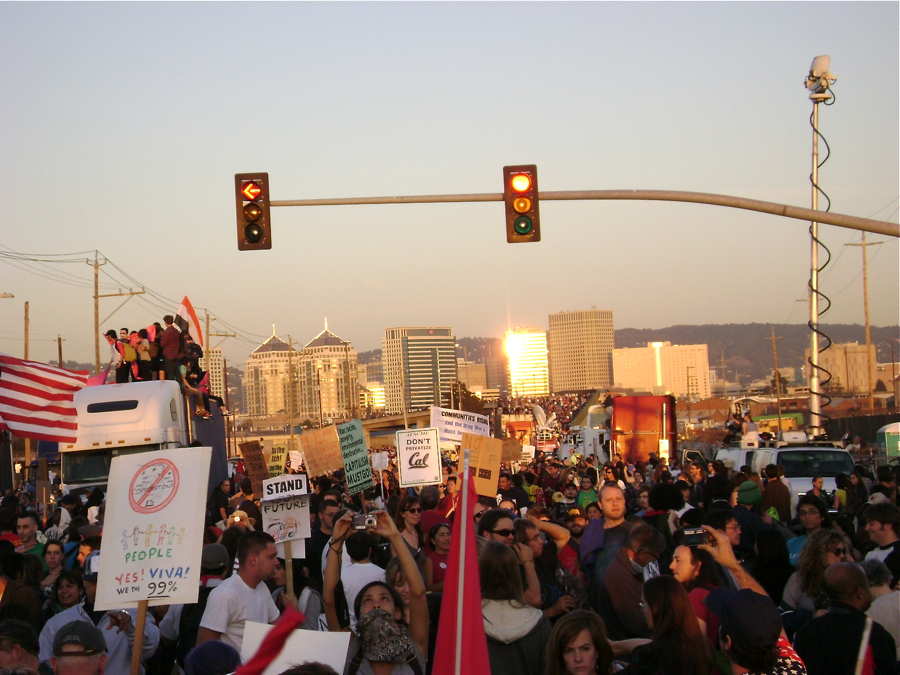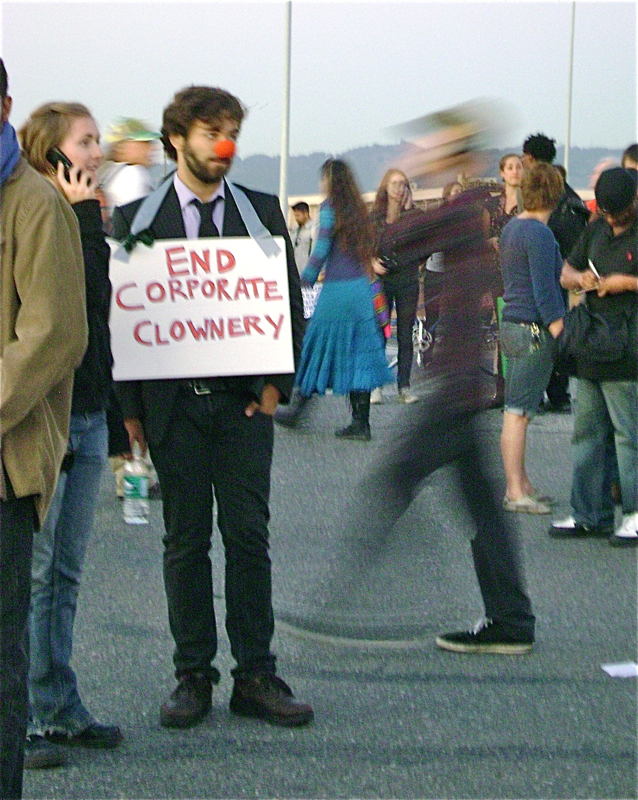See related slideshowI arrived at Occupy Oakland Wednesday a few hours before the planned march to the Port for what was supposed to be a teach-in about food justice. But by 3:30 p.m. the speakers had stopped trying to compete with the warring musical factions on either side of Frank Ogawa Plaza — hip hop versus reggae — and the event had devolved into one break-out session and a few people milling around holding signs about Big Food.
I found one food activist — Paul Towers of Pesticide Action Network — holding a smart sign depicting an octopus with each tentacle representing a different major pesticide company (Monsanto, Dow, Sungenta, and others). When I asked him whether he was planning to join the march, he was skeptical. He had heard the Occupy folks hadn’t succeeded in negotiating with the labor unions involved — and besides, he said, “I think it’s almost three miles. That seems like a long way for this crowd.”
I looked around at the punk kids smoking pipes in tents, the man dressed in a sort of new-age wizard costume, and the people in the free food line who already looked a little weary, and wondered if he was right.
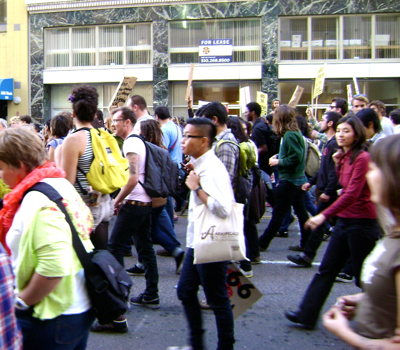 By 5 p.m., however, a diverse group of students, families, and workers had piled out of the BART train stations and into the streets of downtown Oakland. Clearly many of the participants had come from work — meaning the day hadn’t materialized into the ambitious “general strike” organizers had called for. But the Bay Area was turning out nonetheless to echo the Occupy Wall Street message and “disrupt the flow of capital.”
By 5 p.m., however, a diverse group of students, families, and workers had piled out of the BART train stations and into the streets of downtown Oakland. Clearly many of the participants had come from work — meaning the day hadn’t materialized into the ambitious “general strike” organizers had called for. But the Bay Area was turning out nonetheless to echo the Occupy Wall Street message and “disrupt the flow of capital.”
Many of the protesters were also marching to stand up to Mayor Jean Quan and the Oakland police force, which had tear-gassed protesters and left war veteran Scott Olsen laying in the street with a fractured skull at last week’s well-publicized confrontation.
So off we went, at 5 o’clock on the dot. Our path took us over the 880 freeway through the low-income West Oakland neighborhood. We snaked over another overpass just as the sun was getting low in the sky to find hundreds of protesters (many of whom had arrived there earlier in the afternoon) piled on top of a row of parked trucks and shipping containers, dancing and waving flags.
This is when it began to be clear that there were formidable numbers of us on the move. Soon the local news media would start throwing out numbers (ABC initially reported 4,500, but some sources are reporting as many 10,000 people). Those of us there were simply moved by the sense that the mass of people behind us had no visible end.
I found myself hunting down the smartest, cleverest protest signs to snap photos of my favorites. One woman had a small, elegant sign reading “Fuck the police” in glittery cursive. Another near me said “Pollution is not a business plan.” A friend of a friend had made a sign for his son that read “Educate me now or deal with me later,” and one man in a clown nose had a sign that read “End corporate clownery” hung around his neck. The “world’s nerdiest protest sign” — my favorite — presented a series of charts and graphs detailing the increasing class divide in this country.
At 6:15 p.m., the Port released a press release announcing that “Maritime Operations are Effectively Shutdown.” But the sheer size of the crowd meant the message didn’t reach most protesters, let alone the #OccupyOakland Twitter feed, until later.
In the meantime, mixed messages rippled through the crowd (Oakland’s demonstrators, unlike those in New York’s Zuccotti Park, haven’t yet mastered the call-and-response “human microphone” technique). The original goal had been to block port workers’ entrance in time for the 7 p.m. shift change; now there was speculation that the shift had been moved to 8 p.m. to avoid the crowd. As darkness fell, many protesters stayed put.
Cars full of workers took a variety of approaches to leaving the port. Some abandoned their trucks in the crowd, while others tried to ram though the masses. The latter got swarmed and had their doors kicked. Each time that happened, the crowd swelled with chants of “peaceful, peaceful, peaceful.” 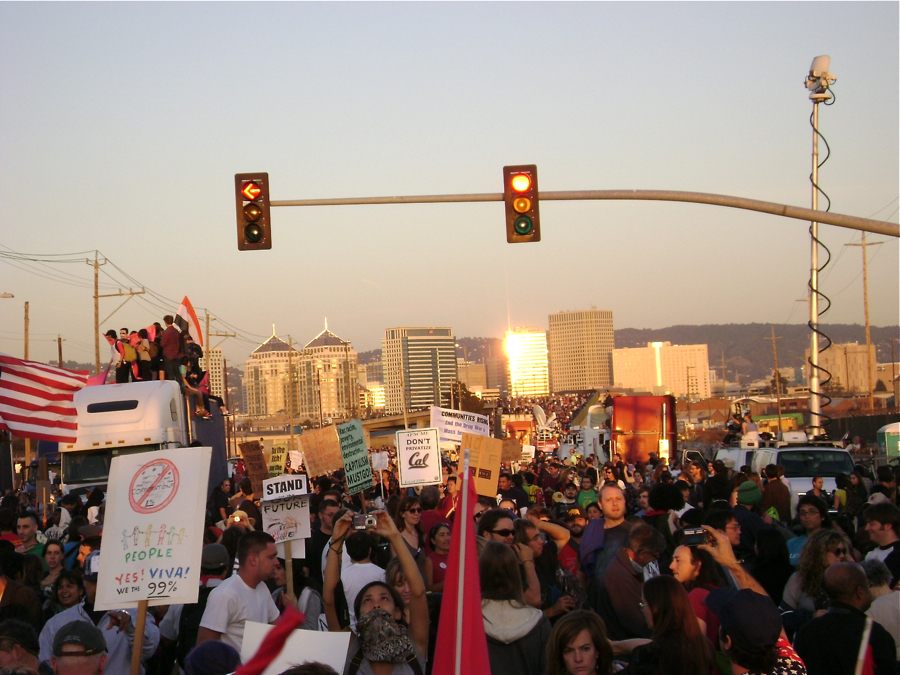
Shortly before 8 p.m., someone with a bullhorn announced, “We’ve just heard from a representative of the Longshoremen’s Union and no one is going to work tonight!” There was one ship scheduled for 3 a.m., the organizer added — but if even 10 people were left at the port by then, the Longshoremen would stay away.
This was our cue to make the long, slow trudge back downtown, and most of the crowd started moving. Water bottles and provisions were brought in for the die-hards — “surely there must be 10 other people here willing to sit it out for five more hours,” we all thought to ourselves.
One man on a cell phone beside me tried to describe the night to a friend on the walk back: “It was a very confusing protest, because the number of experienced organizers was so dwarfed by the crowd,” he said. “For the WTO protests in Seattle,” he recalled, “we took months to plan. But this is all happening so fast.” He wore a T-shirt emblazoned with an image I’ve seen so many times in the progressive enclaves of the Bay Area over the years, I’ve nearly stopped noticing it — one that depicts a big fish about to be gobbled by a school of smaller fish.
By this point exhaustion had set in. While the night’s events would appear all over the national media by morning, we had far from solved all the problems the Occupy movement hopes to address. (There would be another clash late last night between police and “a small group of anarchists” involving tear gas and the arrests of between 60 and 90 people.) I didn’t think too much about whether the message on my neighbor’s T-shirt was clever; but I didn’t need to. I had just been reminded that it’s true.
